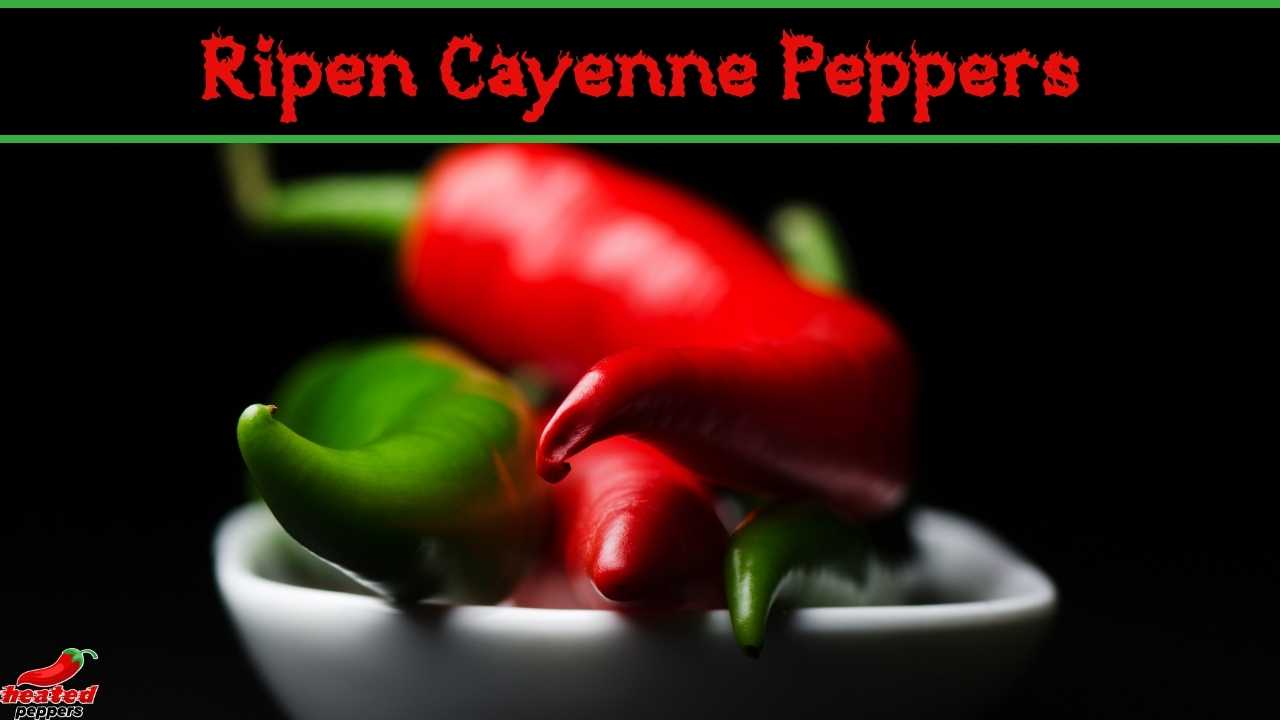Cayenne peppers are renowned for their fiery heat and bold flavor, adding a spicy kick to a wide range of dishes.
While most people are familiar with red and green cayenne peppers, there are significant differences beyond their outward appearance.
In this article, we will delve into the characteristics of red and green cayenne peppers, exploring their taste, heat level, nutritional value, and more.

Table of Contents
Are Red Cayenne Peppers and Green Cayenne Peppers the Same Pepper?
When it comes to red and green cayenne peppers, they are typically the same pepper at different stages of ripeness.
However, it’s important to note that cayenne peppers undergo a fascinating transformation as they mature from green to red, displaying various colors in-between, such as yellow and orange.
Let’s take a closer look at the ripening stages:
Ripening Stages of Cayenne Peppers
Cayenne peppers progress through distinct ripening stages, each characterized by a unique color and flavor profile:
- Immature Stage (Green): At the early stages of development, cayenne peppers are green. They are crisp, slightly bitter, and possess a vibrant freshness.
- Intermediate Stages (Yellow or Orange): As the peppers continue to ripen, they transition to shades of yellow or orange. During this stage, the peppers become sweeter and milder in flavor compared to their green counterparts.
- Fully Ripe Stage (Red): The mature stage of cayenne peppers is marked by a bright red color. Red cayenne peppers are known for their intense heat and robust, sweet flavor. They offer a perfect balance of heat and sweetness, making them a popular choice in various culinary applications.
Ripeness Stage Table:
| Stage | Color |
|---|---|
| Immature | Green |
| Intermediate | Yellow or Orange |
| Fully Ripe | Red |
While the majority of cayenne peppers follow this ripening process, it’s worth mentioning that there are exceptions.
Some hybrid varieties are specifically bred to maintain a green hue throughout the growing season.
These unique varieties offer the crispness and mild heat of green cayenne peppers even when fully mature.
Here’s a video explaining the different colors of peppers, he’s talking about bell peppers but the same information applies to cayenne peppers as well:
Do Green Cayenne Peppers Taste Different than Red Cayenne Peppers?
One noticeable difference between green and red cayenne peppers is their taste.
The extra time red cayenne peppers spend on the vine allows them to develop a sweeter flavor compared to their green counterparts.
The sweetness is a result of the longer ripening period, which allows the peppers to convert starches into natural sugars.
On the other hand, green cayenne peppers exhibit a brighter and slightly bitter taste.
Flavor Profiles of Red and Green Cayenne Peppers
To better understand the taste distinctions, let’s examine the flavor profiles of both red and green cayenne peppers:
- Red Cayenne Peppers: Fully ripe red cayenne peppers offer a delightful combination of sweetness and heat. Their flavor is characterized by a pleasant fruity undertone, complemented by a moderate level of spiciness. The sweetness brings balance to the intense heat, making red cayenne peppers popular for adding a fiery kick to dishes while still imparting a subtle sweetness.
- Green Cayenne Peppers: Green cayenne peppers, being less mature, exhibit a brighter and more pronounced bitterness. The flavor is vibrant and slightly tangy, with a moderate to high level of spiciness. Green cayenne peppers are favored for their distinct flavor and are commonly used in salsas, hot sauces, and dishes that benefit from their tangy and zesty profile.
The difference in taste between red and green cayenne peppers allows for diverse culinary applications, depending on the desired flavor experience.
Taste Comparison Table:
| Aspect | Red Cayenne Peppers | Green Cayenne Peppers |
|---|---|---|
| Sweetness | Higher | Lower |
| Bitterness | Low | Moderate |
| Brightness | Moderate | High |
Are Green Cayenne Peppers Hotter than Red Cayenne Peppers?
Heat is a significant aspect to consider when discussing chili peppers, including cayenne peppers. Red cayenne peppers tend to be hotter than green cayenne peppers.
The longer time red cayenne peppers spend on the vine allows them to accumulate more capsaicin, the compound responsible for their fiery sensation.
Capsaicin content contributes to the overall heat level of a chili pepper. The increased capsaicin content in red cayenne peppers makes them hotter compared to green cayenne peppers.
Understanding Heat Levels: Scoville Heat Range
To gauge the heat of chili peppers, including cayenne peppers, the Scoville heat scale is often used.
This scale measures the concentration of capsaicinoids, the compounds responsible for the pungency or heat sensation.
Red cayenne peppers usually fall within the upper range of the Scoville scale, while green cayenne peppers tend to be milder.
It’s important to note that individual tolerance to heat can vary, and personal perception of spiciness may differ.
However, as a general guideline, red cayenne peppers are hotter due to their longer vine time and higher capsaicin content.
Heat Comparison Table:
| Heat Level | Red Cayenne Peppers | Green Cayenne Peppers |
|---|---|---|
| Scoville Rating | Upper range | Milder |
| Capsaicin Content | Higher | Lower |
Are Red Cayenne Peppers Healthier for You than Green Cayenne Peppers?
Both red and green cayenne peppers offer health benefits and are generally considered healthy additions to your diet.
However, due to their longer time on the vine, red cayenne peppers have more time to develop essential vitamins, minerals, antioxidants, and capsaicin, which contribute to their health-promoting properties.
Let’s explore the nutritional differences between the two:
Nutritional Profile: Red Cayenne Peppers vs. Green Cayenne Peppers
While both red and green cayenne peppers offer similar nutritional benefits, the extended ripening period of red cayenne peppers allows them to develop higher levels of certain nutrients.
Here’s a comparison of their nutritional profiles:
- Vitamin C: Red cayenne peppers contain higher levels of vitamin C compared to green cayenne peppers. Vitamin C plays a crucial role in boosting the immune system, promoting collagen production, and acting as a powerful antioxidant.
- Vitamin A: Red cayenne peppers also tend to have higher levels of vitamin A, which contributes to healthy vision, skin, and immune function.
- Antioxidants: The longer ripening time allows red cayenne peppers to accumulate more antioxidants. These compounds help protect the body against oxidative stress and inflammation, potentially reducing the risk of chronic diseases.
- Capsaicin: Red cayenne peppers boast higher capsaicin content, contributing to their distinct heat and potential health benefits associated with capsaicin consumption, such as pain relief, improved metabolism, and appetite suppression.
Nutritional Comparison Table:
| Nutrient | Red Cayenne Peppers | Green Cayenne Peppers |
|---|---|---|
| Vitamin C | Higher | Lower |
| Vitamin A | Higher | Lower |
| Antioxidants | Higher | Lower |
| Capsaicin | Higher | Lower |
If Red Cayenne Peppers are Healthier, Why Do We See More Green Cayenne Peppers in Supermarkets?
The availability of green cayenne peppers in supermarkets can be influenced by various factors, including taste preferences and profit margins.
Let’s explore the reasons why green cayenne peppers are more commonly found in grocery stores:
Taste Preferences and Culinary Versatility
- Bright Bite: Green cayenne peppers possess a vibrant, tangy flavor that appeals to many individuals. The distinct bitterness and brightness can elevate the taste profile of various dishes, particularly when a sharper taste is desired.
- Culinary Versatility: Green cayenne peppers are incredibly versatile in the kitchen. They can be used in both raw and cooked applications, such as salsas, stir-fries, pickling, and stuffing. Their vibrant color and unique flavor add a refreshing twist to culinary creations.
Cost and Cultivation Factors
- Lower Cost: Green cayenne peppers are often more affordable than their red counterparts. This lower cost can be attributed to various factors, such as higher yield per plant, shorter ripening time, and less labor-intensive harvesting.
- Ease of Cultivation: Green cayenne peppers are relatively easier to cultivate compared to red cayenne peppers. They have a shorter maturation period, making them suitable for commercial cultivation and allowing farmers to produce larger quantities at a faster rate.
- Profit Margins: The lower cost and easier cultivation of green cayenne peppers contribute to a larger profit margin for supermarkets. This economic factor plays a significant role in determining which varieties are more readily available to consumers.
Conclusion
In conclusion, red and green cayenne peppers share the same lineage but exhibit noticeable differences in taste, heat level, and nutritional profile.
Red cayenne peppers offer a sweeter taste, higher heat level, and richer nutritional value due to their longer time on the vine.
On the other hand, green cayenne peppers provide a brighter, slightly bitter taste and are prized for their culinary versatility.
When choosing between red and green cayenne peppers, consider your flavor preferences, desired heat level, and potential health benefits.
Whether you opt for the sweetness of red cayenne peppers or the vibrant bite of green cayenne peppers, both varieties add a spicy touch to your favorite dishes and elevate your culinary experiences.




